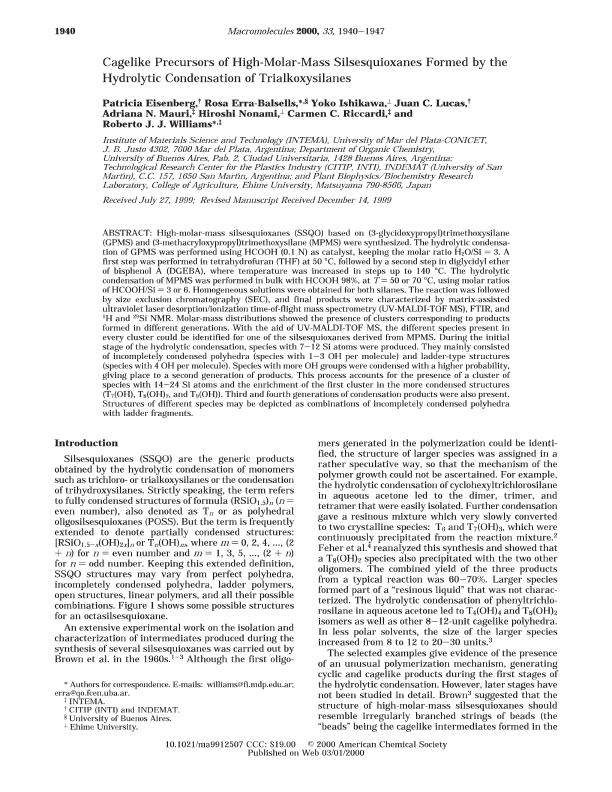Artículo
Cagelike precursors of high-molar-mass silsesquioxanes formed by the hydrolytic condensation of trialkoxysilanes
Eisenberg, Patricia; Erra Balsells, Rosa ; Ishikawa, Yoko; Lucas, Juan C.; Mauri, Adriana Noemi
; Ishikawa, Yoko; Lucas, Juan C.; Mauri, Adriana Noemi ; Nonami, Hiroshi; Riccardi, Carmen Cristina
; Nonami, Hiroshi; Riccardi, Carmen Cristina ; Williams, Roberto Juan Jose
; Williams, Roberto Juan Jose
 ; Ishikawa, Yoko; Lucas, Juan C.; Mauri, Adriana Noemi
; Ishikawa, Yoko; Lucas, Juan C.; Mauri, Adriana Noemi ; Nonami, Hiroshi; Riccardi, Carmen Cristina
; Nonami, Hiroshi; Riccardi, Carmen Cristina ; Williams, Roberto Juan Jose
; Williams, Roberto Juan Jose
Fecha de publicación:
01/03/2000
Editorial:
American Chemical Society
Revista:
Macromolecules
ISSN:
0024-9297
Idioma:
Inglés
Tipo de recurso:
Artículo publicado
Clasificación temática:
Resumen
High-molar-mass silsesquioxanes (SSQO) based on (3-glycidoxypropyl)trimethoxysilane (GPMS) and (3-methacryloxypropyl)trimethoxysilane (MPMS) were synthesized. The hydrolytic condensation of GPMS was performed using HCOOH (0.1 N) as catalyst, keeping the molar ratio H2O/Si = 3. A first step was performed in tetrahydrofuran (THF) at 50°C, followed by a second step in diglycidyl ether of bisphenol A (DGEBA), where temperature was increased in steps up to 140°C. The hydrolytic condensation of MPMS was performed in bulk with HCOOH 98%, at T = 50 or 70°C, using molar ratios of HCOOH/Si = 3 or 6. Homogeneous solutions were obtained for both silanes. The reaction was followed by size exclusion chromatography (SEC), and final products were characterized by matrix-assisted ultraviolet laser desorption/ionization time-of-flight mass spectrometry (UV-MALDI-TOF MS), FTIR, and 1H and 29Si NMR. Molar-mass distributions showed the presence of clusters corresponding to products formed in different generations. With the aid of UV-MALDI-TOF MS, the different species present in every cluster could be identified for one of the silsequioxanes derived from MPMS. During the initial stage of the hydrolytic condensation, species with 7-12 Si atoms were produced. They mainly consisted of incompletely condensed polyhedra (species with 1-3 OH per molecule) and ladder-type structures (species with 4 OH per molecule). Species with more OH groups were condensed with a higher probability, giving place to a second generation of products. This process accounts for the presence of a cluster of species with 14-24 Si atoms and the enrichment of the first cluster in the more condensed structures (T7(OH), T8(OH)2, and T9(OH)). Third and fourth generations of condensation products were also present. Structures of different species may be depicted as combinations of incompletely condensed polyhedra with ladder fragments.
Archivos asociados
Licencia
Identificadores
Colecciones
Articulos(INTEMA)
Articulos de INST.DE INV.EN CIENCIA Y TECNOL.MATERIALES (I)
Articulos de INST.DE INV.EN CIENCIA Y TECNOL.MATERIALES (I)
Citación
Eisenberg, Patricia; Erra Balsells, Rosa; Ishikawa, Yoko; Lucas, Juan C.; Mauri, Adriana Noemi; et al.; Cagelike precursors of high-molar-mass silsesquioxanes formed by the hydrolytic condensation of trialkoxysilanes; American Chemical Society; Macromolecules; 33; 6; 1-3-2000; 1940-1947
Compartir
Altmétricas



